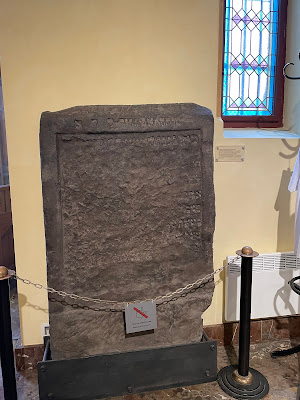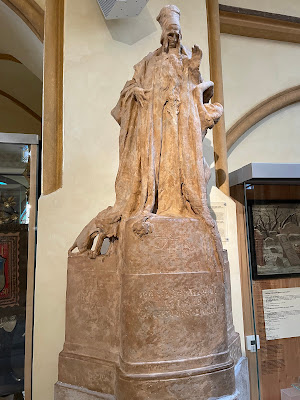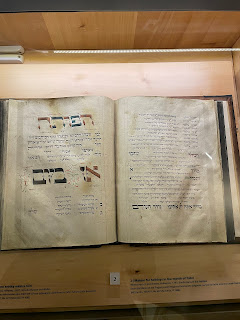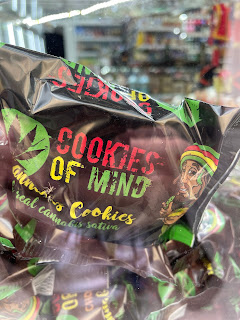Prague - Josefov, the former Jewish ghetto, now called 'Jewish Quarter' is dotted with somber reminders of its past. These include the weathered tombstones of the Old Jewish Cemetery, and the Pinkas Synagogue, now a Holocaust memorial with exhibits focusing on Jewish children. The Jewish Museum houses a huge collection of cultural artifacts.
Ticket is 500cz per person that allows us to visit all the Synagogue in Jewish town for 3 days and only once, but we completed all the sites in one day. The Klausen Synagogue and Ceremonial Hall was closed.
By the fall of 1941, the first trains left for the concentration camp established in Terezin (Theresienstadt). From there, Jews were deported to extermination camps in Eastern European countries in 1942-1944. About 80,000 out of 120,000 Czech Jews living in Bohemia and Moravia prior to the war were killed. In 2022, the Federation of Jewish Communities estimated that there are between 3,000 and 5,000 Jews in the Czech Republic, of which 1,600 live in Prague.
SPANISH SYNAGOGUE
This is the most recent synagogue in the Prague Jewish town, built in 1868 in a striking Moorish Revival style. The synagogue got its name from the Moorish style that had been greatly influenced by Spanish architecture. The exhibits display Jews in Bohemian lands from 19th-20th Centuries.
Upon entering the synagogue, visitors are immediately struck by the opulent interior. The walls and ceiling are adorned with elaborate geometric patterns and vibrant colors, reminiscent of the Alhambra in Spain, which inspired the synagogue's name. The stained glass windows cast a warm, colorful glow, creating an atmosphere of reverence and beauty.
 |
| Synagogue Altar |
The synagogue's history is as rich as its decoration. It has witnessed the evolution of Prague's Jewish community, serving as a spiritual and cultural hub for generations. During World War II, the synagogue was used as a storage space for confiscated Jewish property by the Nazis. Despite these dark times, the synagogue survived and was restored to its former glory in the post-war years.
Today, the Spanish Synagogue is part of the Jewish Museum in Prague and houses a fascinating exhibition on the history of Jews in Bohemia and Moravia. Walking up to the 2nd floor of the Synaogue.
 |
| Synagogue upstairs |

The museum's collection includes religious artifacts, historical documents, and art, providing a comprehensive overview of the Jewish experience in the region.
 |
| Synagogue ceiling |
 |
| Altar view from 2nd floor |
 |
| Majestic piped organ |
ROBERT GUTTMANN GALLERY
Named after the celebrated Czech-Jewish artist Robert Guttmann, this gallery is part of the Jewish Museum in Prague and provides a unique space for rotating exhibitions that delve into various aspects of Jewish life, art, and history.
 |
| Quin outside the gallery |
The gallery dedicated to his memory continues his legacy by showcasing not only his works but also a diverse range of exhibitions that reflect the breadth and depth of Jewish culture.
One of the most striking features of the Robert Guttmann Gallery is its commitment to contemporary relevance. While it honours the past, it also embraces the present by featuring modern Jewish artists and exploring current issues through the lens of art and culture. This dynamic approach ensures that every visit offers something new and thought-provoking.
The exhibitions at the gallery are meticulously curated, often drawing from the extensive collections of the Jewish Museum.
The space is thoughtfully arranged to encourage reflection and connection, making it a perfect spot for both casual visitors and serious art enthusiasts.
 |
| Quin on the typewriter |
OLD-NEW SYNAGOGUE
The oldest continuously active synagogue in Europe, built in the 1280 in the Gothic style. This architectural gem has been a cornerstone of Jewish life in Prague for over 700 years.
 |
| Pews around the Synagogue |

Constructed in the late 13th century, the Old-New Synagogue is an exquisite example of early Gothic architecture. Its imposing walls and high, rib-vaulted ceilings reflect the strength and resilience of a community that has weathered centuries of change and challenge.
 |
| The Altar |
One of the most captivating features of the Old-New Synagogue is its intricate symbolism and design.
 |
| Around the Synagogue |
Photos of the missing Israeli were on the postcard around the Synagogue.
The building's exterior is marked by its stepped gables and pointed arches, typical of Gothic style, while the interior is adorned with beautiful ironwork and elaborate stone carvings. The sanctuary's focal point is the bimah, an elevated platform from which the Torah is read, surrounded by medieval wrought-iron railings that are as functional as they are decorative.
Legend and mystique also surround the Old-New Synagogue. According to one popular legend, the stones used to build the synagogue were brought by angels from the ruins of the Second Temple in Jerusalem, giving rise to its name, "Altneuschul" (Old-New).
Another famous tale speaks of the Golem of Prague, a mythical creature said to have been created by Rabbi Judah Loew ben Bezalel, the Maharal of Prague, to protect the Jewish community. It is whispered that the remains of the Golem lie in the attic of the synagogue, adding an air of mystery to this ancient structure.
MAISEL SYNAGOGUE
Built in 1592 by the affluent Jewish businessman and philanthropist Mordechai Maisel, the synagogue was originally constructed as a private place of worship for Maisel and his family. Maisel, who was also the mayor of the Jewish Town, funded the synagogue's construction and many other projects, contributing significantly to the development of the Jewish Quarter. His legacy is intricately woven into the fabric of Prague's Jewish history, and the synagogue remains a testament to his vision and generosity.
The Maisel Synagogue was designed in a Renaissance style, which was a departure from the Gothic architecture that characterised many other synagogues of the time.
One of the most striking features of the Maisel Synagogue is its facade, adorned with intricate decorative elements that reflect both Renaissance and Baroque influences.
The beautiful interior, with its elegant arches and ornate decorations, creates an atmosphere of reverence and historical significance. The synagogue's design is not just a testament to architectural beauty but also a symbol of the resilience and enduring spirit of Prague's Jewish community.
The permanent exhibition, "Jews in the Bohemian Lands, 10th-18th Century," offers an extensive collection of artifacts, manuscripts, and religious objects that narrate the rich and often tumultuous history of Jews in the region.
One of the highlights of the exhibition is the display of valuable Judaica, including Torah scrolls, silverware, and ceremonial textiles, each piece telling a unique story of Jewish faith and tradition.
 |
| Altar |
The museum also sheds light on the influential figures of the Jewish community, their contributions to society, and the challenges they faced throughout history.
LUNCH @ CITY HALLBISTRO
The menu were in Czech and the counter lady explained slowly in English what the menu meant. Finally we ordered the below mentioned.
 |
| Chicken wrapped in bacon with potato wedges |
 |
| My lunch |
Lunch was a Pasta Mushroom Goulash - it tasted not so pleasant but I finished it. My family took pity on me and donated some of their lunch to my plate - lol.
ANTIQUE WATCH SHOP
There were quite a number of watch and antique shops and we went into some of the shops to take a look. Old wall clocks, pocket watches and antique Omega watches were on display.
PINKAS SYNAGOGUE
Originally built in 1535 by Aaron Meshullam Horowitz, the Pinkas Synagogue is one of the oldest surviving synagogues in Prague. It was constructed as a private place of worship for the Horowitz family and later became a public synagogue. The building's design reflects the Gothic and Renaissance architectural styles of the period, with its distinctive arched windows and vaulted ceilings.
 |
| Names of Holocaust victims |
One of the most striking features of the Pinkas Synagogue is its interior, which serves as a memorial to the nearly 80,000 Czech Jews who perished during the Holocaust.
The walls of the synagogue are inscribed with the names of the victims, meticulously hand-painted in a solemn tribute to their memory.
This powerful memorial, known as the Memorial to the Victims of the Shoah from the Czech Lands, was created in the 1950s and remains a moving and sobering reminder of the atrocities of the Holocaust.
 |
| Ceiling of the Synagogue |
 |
| Names of victims on the walls |
The exhibition includes photographs, personal documents, and other artifacts that tell the stories of the individuals who suffered and perished during this dark period in history. Visitors can gain a deeper understanding of the impact of the Holocaust on the Jewish community and the resilience of those who survived.
 |
| children drawings in concentration camps |
The children pictures depicts the traumas of losing loved one and the cruelty within the concentration camps.
OLD JEWISH CEMETERY
Pax was explaining to us that the small pebbles on the tombstones depicts respects on famous Jewish prominent people.
 |
| Old Jewish Cemetery |
Stareho Hrbitova
Small stores selling souvenirs and stuff.
Marijuana is sold in all types
Franz Kafka Rotating Head
This kinetic sculpture, dedicated to one of Prague's most famous literary figures, Franz Kafka, is a striking blend of art, technology, and homage, and it provides a unique way to engage with the legacy of the enigmatic writer.
The Franz Kafka Rotating Head, also known as "Metalmorphosis," is a 42-ton, 11-meter tall sculpture created by the renowned Czech artist David Černý.
 |
| Quadrio shopping centre |
Installed in 2014 near the Quadrio shopping center, the sculpture consists of 42 rotating stainless steel panels that form the head of Franz Kafka. Each layer can move independently, creating a dynamic and constantly changing visual experience that mirrors the complexities and surreal nature of Kafka's works.
Wenceslas Square, a bustling hub of history, culture, and commerce, stands as one of Prague’s most iconic landmarks. Located in the heart of the New Town (Nové Město), this grand boulevard is not just a place but an experience, pulsating with the vibrant energy of the Czech capital.
 |
| Wencesles Square |
 |
| Statue of Saint Wenceslas |
 |
| Museum of Art History |
Lucerna
 |
| Knight on upside down horst |
 |
| Hanging Piano |
Dinner @ Pizzarie Paradise
 |
| Gnocci in Bolognese sauce |
 |
| Pizza Hawaiian |
 |
| Seafood Pizza |
 |
| Mixed mean Pizza |
After this hearty dinner, we headed home and rested.










































































No comments:
Post a Comment